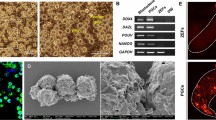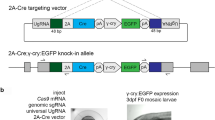Abstract
Expression of transgenes within a single generation by direct DNA injection into vertebrate embryos has been plagued by inefficient and nonuniform gene expression. We report a novel strategy for efficient and stable expression of transgenes driven by both ubiquitous and tissue-specific promoters by direct DNA injection into developing Xenopus laevis embryos. This strategy involves flanking expression cassettes of interest with inverted terminal repeat sequences (ITRs) from adeno-associated virus. Our results suggest that the ITR strategy may be generally applicable to other systems, such as zebra fish and embryonic stem cells, and may enable tissue-specific expression of transgenes in problematic contexts.
This is a preview of subscription content, access via your institution
Access options
Subscribe to this journal
Receive 12 print issues and online access
$209.00 per year
only $17.42 per issue
Buy this article
- Purchase on Springer Link
- Instant access to full article PDF
Prices may be subject to local taxes which are calculated during checkout
Similar content being viewed by others
References
Vize, P.D., Hemmati-Brivanlou, A., Harland, R.M. and Melton, D.A. 1991. Assays for gene function in developing Xenopus embryos, pp. 367–387 in Xenopus laevis: Practical uses in cell and molecular biology. Kay, B.K. and Peng, H.B. (eds.). Academic Press, London.
Kroll, K.L. and Amaya, E. 1996. Transgenic Xenopus embryos from sperm nuclear transplantations reveal FGF signaling requirements during gastrulation. Development 122:3173–3183.
Kroll, K.L. and Gerhart, J.C. 1994. Transgenic X. laevis embryos from eggs transplanted with nuclei of transfected cultured cells. Science 266:650–653.
Lebkowski, J.S., McNally, M.M., Okarma, T.B. and Lerch, L.B. 1988. Adeno-associated virus: a vector system for efficient introduction and integration of DNA into a variety of mammalian cell types. Mol. Cell. Biol. 8:3988–3996.
Lusby, E., Fife, K.H. and Berns, K.I. 1980. Nucleotide sequence of the inverted terminal repetition in adeno-associated virus DNA. J. Virol. 34:402–409.
Lefebvre, R.B., Riva, S. and Berns, K.I. 1984. Conformation takes precedence over sequence in adeno-associated virus DNA replication. Mol. Cell. Biol. 4:1416–1419.
Wang, X.S., Ponnazhagan, S. and Srivastava, A. 1995. Rescue and replication signals of the adeno-associated virus 2 genome. 250:573–580.
Berns, K.I. and Linden, R.M. 1995. The cryptic life style of adeno-associated virus. Bioessays 17:237–245.
Philip, R., Brunette, E., Kilinski, L., Murugesh, D., McNally, M.A., Ucar, K. et al. 1994. Efficient and sustained gene expression in primary T lymphocytes and primary and cultured tumor cells mediated by adeno-associated virus plasmid DNA complexed to cationic liposomes. Mol. Cell. Biol. 14:2411–2418.
Lusby, E., Fife, K.H. and Berns, K.I. 1980. Nucleotide sequence of the inverted terminal repetition in adeno-associated virus DNA. J. Virol. 34:402–409.
Nieuwkoop, P. and Faber, J. 1956. Normal table of Xenopus laevis. Daudin North-Holland, Amsterdam, The Netherlands.
Marini, N.J. and Benbow, R.M. 1991. Differential compartmentalization of plasmid DNA microinjected into Xenopus laevis embryos relates to replication efficiency. Mol. Cell. Biol. 11:299–308.
Etkin, L.D. and Pearman, B. 1987. Distribution, expression and germ line transmission of exogenous DNA sequences following microinjection into Xenopus laevis eggs. Development 99:15–23.
Flotte, T.R., Afione, S.A. and Zeitlin, P.A. 1994. Adeno-associated virus vector gene expression occurs in nondividing cells in the absence of vector DNA intrgration. Am. J. Respir. Cell Mol. Biol. 11:517–521.
Mohun, T.J., Garrett, N.J. and Gurdon, B. 1986. Upstream sequences required for tissue-specific activation of the cardiac actin gene in Xenopus laevis embryos. EMBO J. 5:3185–3193.
Weitzman, M.D., Fisher, K.J. and Wilson, J.M. 1996. Recruitment of wild-type and recombinant adeno-associated virus into adenovirus replication centers. J. Virol. 70:1845–1854.
Porter, S.D. and Meyer, C.J. 1994. A distal tyrosinase upstream element stimulates gene expression in neural-crest-derived melanocytes of transgenic mice: position-independent and mosaic expression. Development 120:2103–2111.
Harland, R.M. 1991. In situ hybridization: an improved whole mount method for Xenopus embryos, pp. 685–695 in Xenopus laevis: practical uses in cell and molecular biology, Kay, B.K. and Peng, H.B, (eds.), Academic Press, London, UK.
Turner, D.L. and Weintraub, H. 1994. Expression of acnaete-scute homolog 3 in Xenopus embryos converts ectodermal cells to a neural fate. Genes Development 8:1434–1447.
Author information
Authors and Affiliations
Corresponding author
Rights and permissions
About this article
Cite this article
Fu, Y., Wang, Y. & Evans, S. Viral sequences enable efficient and tissue-specific expression of transgenes in Xenopus. Nat Biotechnol 16, 253–257 (1998). https://doi.org/10.1038/nbt0398-253
Received:
Accepted:
Issue Date:
DOI: https://doi.org/10.1038/nbt0398-253
This article is cited by
-
Detection of Calcium Transients in Embryonic Stem Cells and Their Differentiated Progeny
Cellular and Molecular Neurobiology (2009)
-
Astrocytic expression of transgene in the rat brain mediated by baculovirus vectors containing an astrocyte-specific promoter
Gene Therapy (2006)



